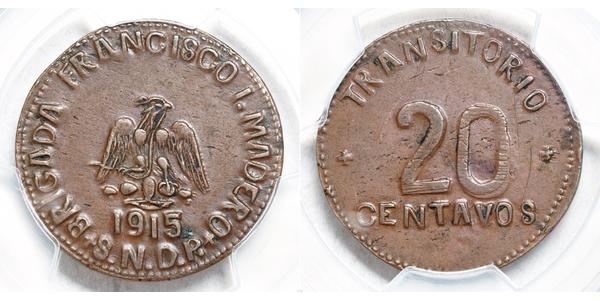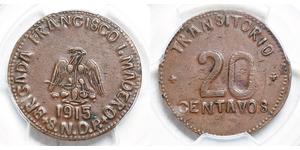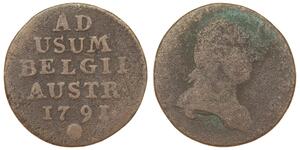20 Centavo
1915, Mexico, Puebla, Chiconcuautla. Nice Copper 20 Centavos Coin. PCGS AU-55!
Mint Year: 1915
Reference: KM-757.
Denomination: 20 Centavos
Condition: Certified and graded by PCGS as AU-55!
Weight: ca. 9.5gm
Material: Copper
Diameter: 28mm
Obverse: Eagle standing on a cactus plant, which grows from an island, holding snake with beak and claws.
Legend: BRIGADA FRANCISCO I. MADERO. S. B. D. R.
Reverse: Large value numeral, flanked by rosettes.
Legend: TRANSITORIO / 20 CENTAVOS
The Mexican Revolution (Spanish: Revolución mexicana) or Mexican Civil War (Spanish: Guerra civil mexicana) was a major armed struggle that started in 1910, with an uprising led by Francisco I. Madero against longtime autocrat Porfirio Díaz, and lasted for the better part of a decade until around 1920. Over time the revolution changed from a revolt against the established order to a multi-sided civil war with frequently shifting power struggles. This armed conflict is often categorized as the most important sociopolitical event in Mexico and one of the greatest upheavals of the 20th century; it resulted in an important experimentation and reformation in social organization.
After prolonged struggles, its representatives produced the Mexican Constitution of 1917 during Venustiano Carranza's term. The revolution is generally considered to have lasted until 1920, although the country continued to have sporadic, but comparatively minor, outbreaks of warfare well into the 1920s. The Cristero War of 1926 to 1929 was the most significant relapse into bloodshed.
Puebla (English: colony, settlement), officially Free and Sovereign State of Puebla (Spanish: Estado Libre y Soberano de Puebla), is one of the 32 states which comprise the Federal Entities of Mexico. It is divided into 217 municipalities and its capital is the city of Puebla.
It is located in east-central Mexico and is bordered by the states of Veracruz to the north and east, Hidalgo, México, Tlaxcala and Morelos to the west, and Guerrero and Oaxaca to the south. The origins of the state lie in the city of Puebla, which was founded by the Spanish in this valley in 1531 to secure the trade route between Mexico City and the port of Veracruz. By the end of the 18th century, the area had become a colonial province with its own governor, which would become the State of Puebla, after the Mexican War of Independence in the early 19th century. Since that time the area, especially around the capital city, has continued to grow economically, mostly through industry, despite being the scene of a number of battles, the most notable of which being the Battle of Puebla. Today, the state is one of the most industrialized in the country, but since most of its development is concentrated in Puebla and other cities, many of its rural areas are undeveloped.
Culturally, the state is home to the china poblana, mole poblano, active literary and arts scenes, and festivals such as Cinco de Mayo, Ritual of Quetzalcoatl, Day of the Dead celebrations (especially in Huaquechula) and Carnival (especially in Huejotzingo). It is home to five major indigenous groups: Nahuas, the Totonacs, the Mixtecs, the Popolocas and the Otomi, which can mostly be found in the far north and the far south of the state.
1 Liard Austrian Netherlands (1713-1795) 銅
本组有 7 钱币 / 7 售价
⇑





 English
English





-300-150-NgSsHgTyCiIAAAGW1HxyjNgw.jpg)







